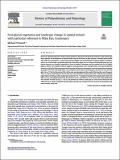| dc.contributor.author | O'Connell, Michael | |
| dc.date.accessioned | 2021-04-12T12:33:35Z | |
| dc.date.available | 2021-04-12T12:33:35Z | |
| dc.date.issued | 2021-01-20 | |
| dc.identifier.citation | O’Connell, Michael. (2021). Post-glacial vegetation and landscape change in upland Ireland with particular reference to Mám Éan, Connemara. Review of Palaeobotany and Palynology, 290, 104377. doi:https://doi.org/10.1016/j.revpalbo.2021.104377 | en_IE |
| dc.identifier.issn | 0034-6667 | |
| dc.identifier.uri | http://hdl.handle.net/10379/16699 | |
| dc.description.abstract | Holocene vegetation dynamics of mid-western Ireland are discussed with particular reference to the Galway and Mayo uplands, the development of upland blanket bog and the history of pine and yew. A detailed pollen profile from Mám Éan (Maumeen), a corrie lake, provides insights into environmental change in upland Connemara where, in recent decades, overgrazing and peat erosion have given rise to serious environmental concerns. Vegetation dynamics are broadly comparable to those in lowland Connemara and also upland sites in the Nephin Begs, Co. Mayo. The available evidence suggests corrie glaciation in the Younger Dryas. The oldest sediments show the usual early Holocene progression from open herbaceous communities to woody vegetation dominated by juniper, tree birch, and finally hazel. Tall canopy trees then spread, including pine, and elm and oak, and later alder (at ca. 7.7 ka). In the interval 10.2 4.8 ka, pine was dominant and for much of this time fires were frequent. There is a distinct mid-Holocene Elm Decline and a short Neolithic Landnam phase that is followed by woodland regeneration involving, at first, mainly pine and later yew. 14C dating of bog-pine from upland sites sheds new light on pine and upland blanket bog development in the mid-Holocene. It is shown that while blanket bog was initiated at Mám Éan by ca. 10.8 ka, the present-day treeless landscape has come about within the last 1000 years as a result of sustained human impact, that has also resulted in severe erosion of minerogenic and, more recently, peaty soils. | en_IE |
| dc.format | application/pdf | en_IE |
| dc.language.iso | en | en_IE |
| dc.publisher | Elsevier | en_IE |
| dc.relation.ispartof | Review Of Palaeobotany And Palynology | en |
| dc.rights | Attribution-NonCommercial-NoDerivs 3.0 Ireland | |
| dc.rights.uri | https://creativecommons.org/licenses/by-nc-nd/3.0/ie/ | |
| dc.subject | Holocene | en_IE |
| dc.subject | Woodland history | en_IE |
| dc.subject | Uplands | en_IE |
| dc.subject | Pollen analysis | en_IE |
| dc.subject | Human impact | en_IE |
| dc.subject | Connemara | en_IE |
| dc.subject | Ireland | en_IE |
| dc.title | Post-glacial vegetation and landscape change in upland Ireland with particular reference to Mám Éan, Connemara | en_IE |
| dc.type | Article | en_IE |
| dc.date.updated | 2021-04-08T12:05:24Z | |
| dc.identifier.doi | 10.1016/j.revpalbo.2021.104377 | |
| dc.local.publishedsource | https://doi.org/10.1016/j.revpalbo.2021.104377 | en_IE |
| dc.description.peer-reviewed | peer-reviewed | |
| dc.internal.rssid | 25527592 | |
| dc.local.contact | Michael O'Connell, Palaeoenvironmental Research Unit, School Of Geography And Archaeology , Https://Nuigalway.Academia.Edu/Michaeloconnell. 0035391492338 Email: michael.oconnell@nuigalway.ie | |
| dc.local.copyrightchecked | Yes | |
| dc.local.version | ACCEPTED | |
| nui.item.downloads | 134 | |


